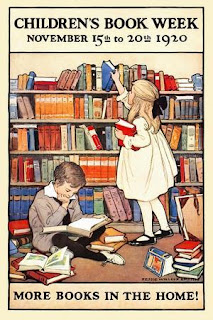Through the Looking Glass Book Reviews
Welcome!
Wednesday, May 25, 2022
An (accidental) Book Expotition in Kansas City - Part Two
Monday, May 23, 2022
A Book Expotition in Kansas City - Part One
 |
| A Sample of Children's Book Week Posters From left to right - Jessie Wilcox 1924, Kate Seredy 1962, Lane Smith 1995 From Left to Right - Jan Brett 1996, Kevin Henkes 2002, Jon J. Muth 2010 |
Saturday, May 14, 2022
A Collector of Books
“I am a dragon. And this is my hoard.”
“You… don’t look like a dragon.”
“Well, hardly anyone does, these days. Times have changed, we have too. The scales and tails thing worked with the dinosaurs, but we learned quite quickly that… that wasn’t going to fly with you people.”
“You were around all the way back to the dinosaurs?”
“Well, not like… me personally. How old do you think I am?”
“… There’s no safe answer to that.”
“No.”
“So… when you say this is your hoard…?”
“All dragons have them. Some stick to the old gold and jewels thing, but that’s so cliché these days. Most of us like our hoards to be a little bit more sophisticated than ‘shiny.’“
“Like what?”
“I have known dragons to collect snowflakes from the first fall of the year over dozens of centuries. I know dragons that collect petals of flowers left on the graves of loved ones. Dragons that keep and care for soft toys and comfort items, left behind as children grow up. Dragons that guard happy memories and shards of sunlight, kept safe for rainy days. And me, I keep a sanctuary of words. A bastion of language, of poetry. Of written music and achingly beautiful prose. I am the Guardian of this monument to linguistic majesty. I collect stories of love and life and death and mourning and joy. There is nothing more beautiful in all the world, no coin or gem or sliver of starlight more fantastic than a well-told tale. A story is this world’s truest treasure, and what better chest for it than a book?”
Thursday, May 12, 2022
Rediscovering treasured books
Sunday, April 17, 2022
Happy (Dachshund) Easter!
Friday, April 15, 2022
Egg decorating in different cultures, with a review of Beautiful Eggs.
Board Book
For ages 4 to 6
Scribble, 2021, 978-1950354436
When we think of egg decorating, we usually think of Easter festivities. Many people in countries around the world decorate boiled or blown eggs for this spring celebration. However, in some cultures they decorate eggs for other celebrations. In Mexico pretty eggs also appear on Cinco de Mayo and other festive days.
People have been decorating eggs for centuries, and they have developed all kinds of ways of making eggs beautiful. A great deal of time and effort can be spent on decorating eggs, and some of these creations are so prized that they are put in museums or art galleries.
In the Ukraine they have been creating extremely colorful eggs that are covered with fine and delicate designs for a long time. Red and green dyes are commonly used, and the designs are drawn on using beeswax.
In the Czech Republic Easter eggs are decorated using many dye colors, and straw. When the eggs are complete, there are “Shiny kaleidoscope patterns” all over them.
In Japan they use washi paper to decorate their eggs. The colorful printed papers, that are also use to make origami, are used to cover the eggs.
With gorgeous collage illustrations and informative pieces of text, the illustrator of this board book introduces children and their grownups to seven different eggs decorating traditions. At the back of the book young readers will find a fold out page that children can use as a stencil to make their own drawing of a decorated egg.
Tuesday, April 12, 2022
An omage to Patricia MacLachlan and her book, Sarah Plain and Tall
 |
| Sarah Plain and Tall by P.J. Lynch |
Friday, April 8, 2022
Celebrating Library Week, and Poetry Month, with a book that gave me hope
Thursday, April 7, 2022
Celebrating Library week with Lee Bennett Hopkins
 |
| From School People edited by Lee Bennett Hopkins |














.jpg)








